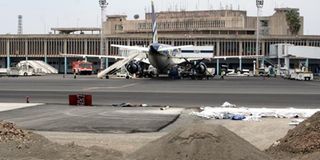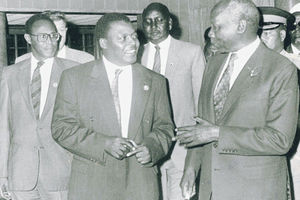Premium
Blackout shines light on dark side of Kenya Airports Authority

Photo/FILE
Nairobi’s Jomo Kenyatta International Airport where a blackout stalled the entire computer system, including the runway lights.
Within the last 10 years, the Kenya Airports Authority has had three disasters: An international terminal was burnt by a massive blaze, a blackout that left an international airport in darkness after generators failed, and a stalled Sh67 billion Greenfield project that saw the State corporation throw Sh4.5 billion into the drain.
When the Jomo Kenyatta International Airport was thrown into darkness on August 25, questions were raised about the management of our airports. The Transport Cabinet Secretary, Kipchumba Murkomen, was forced to apologise and terminated the contract of Managing Director Alex Gitari.
KAA has been a troubled aviation site. When fire broke out at the immigration area on August 7, 2013, it left Kenyans shocked at the level of unpreparedness within the international airport. The available fire engines located within the airport could not contain the blaze. When it was finally extinguished after four hours, it had extensively damaged the international arrivals sections. The fire was attributed to a faulty electricity distribution system.
By the time the fire broke out, KAA was dilly-dallying on the proposed Sh67 billion Greenfield Terminal, a delayed project that was part of Vision 2030.
So many political and commercial interests had converged, which derailed the start of the project brokered during the Kibaki presidency. The mysterious fire unlocked the path towards the December 3, 2013 launch of the Greenfield Terminal project by then President Uhuru Kenyatta. With the launch, it was hoped that Jomo Kenyatta International Airport would get a new passenger terminal and turn Kenya into a regional hub. Proposed to handle 8.7 million passengers a year, with a floor area of 178,000 square metres, this was to be the Jubilee government’s answer to the suffering Kenya Airways and the tourism sector. It was to become the home of the national carrier, Kenya Airways.
According to President Kenyatta, “the construction of this new Greenfield Terminal … (would) enable Kenya attain her National Vision 2030 aspirations to be a middle-income country.”
But it was not that easy.
For that launch alone, KAA had used Sh75 million besides the Sh4.3 billion that was paid to the contractor – Anhui Construction Engineering Group Ltd (ECEG) and China Aero-Technology International Engineering Corporation (CATIC) – before it commenced the work that never was. It was this scandal that would later illustrate the level of wastage at the KAA.
In the year ending June 2021, the Auditor-General Nancy Gathungu revealed that KAA had between 2013 and 2016 spent Sh821 million on five stalled projects – including the Greenfields project. That excludes the Sh4.5 billion already paid for the Greenfield project. There is also a demand from the contractors of Sh17.6 billion which KAA has been negotiating.
It has never been clear why the tender was cancelled after the launch but there were various intrigues. What is known is that the KAA Tender Committee had at its Meeting No 175 on December 15, 2011, approved the award and that letters of notification were issued on December 16, 2011.
On January 10, 2012, under President Kibaki, the Permanent Secretary in the Ministry of Transport wrote a letter asking KAA to annul the tender. More so, the Office of the Prime Minister, Raila Odinga, had written to KAA asking the body not to sign the contract since the government had no budget for the same. Then Permanent Secretary Mohamed Isahakia further told the KAA management that the Cabinet had not approved the project. What looked like a battle between KAA and the ministry was actually a battle of tenderpreneurs.
While technocrats at the Ministry of Transport wanted the tender to be cancelled, the Attorney-General, in a letter dated April 16, 2012, found that investigations conducted by the Ethics and Anti-Corruption Commission did not disclose any irregularity in the instant procurement process so as to warrant delay in implementing the project.
Handled the mess
Kenya’s chance to have an ultra-modern facility was now embroiled in various interests – and chance for Kenya Airways to have a home facility was up in political flames. On July 26, 2012, KAA had directed its Managing Director to issue a letter to the firm of joint venture informing them of the termination of the project. He refused – and relied on the Attorney-General’s opinion.
As the project was caught up in battles, it revealed the issues that kept the body busy, and busybodies busy. Finally, the contractor had to stage a fight within the Ministry of Transport and the matter ended at the Public Procurement Oversight Authority which ordered KAA to go ahead with the tender on August 29, 2012. “The directive by minister (Amos Kimunya) asking KAA CEO to terminate the tender had no basis in law. The contract had already been awarded,” the PPOA said.
It is this whistle-start whistle-stop administrative failures that would be costly later as the Board of KAA and its management were at loggerheads. PPOA was surprised that “there is no evidence that the decision to terminate the tender was communicated to the Anhui Construction Engineering Group Ltd (ECEG) and China Aero-Technology International Engineering Corporation (CATIC) or reported to the Public Procurement Oversight Authority.”
Those mentioned in Parliament as having played a part were Francis Kimemia, head of Public Service and Secretary to the Cabinet, Martin Wambora, then-Chairman of the Kenya Airports Authority Board, and Amos Kimunya, who was Transport minister. By the time the fire broke out on August 2013, the air was already poisoned. The only way out was to hire an expatriate who would inject neutrality.
When Jonny Anderson joined KAA in July 2016 from Avinor AS in Norway, where he was the director, National Airports, he had hoped to turn around its fortunes. The airport fire had led to the reconstruction and upgrading of the airport – and forgotten was the Greenfield project. Finally, President Kenyatta questioned its viability and ordered its cancellation. His argument was that the new facility could accommodate the number of visitors they envisaged at Greenfield.
“There is no need to use another Sh50 billion on that… Let us now focus on roads and other areas that that money would be better utilised and spent.” Odinga warned that “the cancellation of the Greenfield Nairobi airport will deny Kenyans strategic expansion and kill our competitiveness.
Further, the cancellation at a minimum will cost Kenya taxpayers Sh15 billion”. It was Anderson who was left to handle the mess. KAA had by then paid Sh4.3 billion, yet there was nothing on the ground. Recovering the money was becoming a nightmare. “This is the most complex matter. I have never seen anything like this before,” he told Parliament.
On September 30, 2019, he left for what he called “personal reasons” and “after deep reflection and consultation with my family”. Why Anderson was not willing to renew his contract was never known. But KAA must have been unkind to him. In July 2019, before he left, Anderson was put under pressure to justify the cancellation of the Sh64.5 billion Greenfield project.
More so, the National Assembly’s Public Investment Committee (PIC) was threatening to declare him a hostile witness if he did not produce all the documents surrounding the procurement.
In 2019, the Chinese firm was demanding Sh22 billion for the botched project. Already, Sh4.3 billion had been paid before its termination and now Sh17.6 billion was pending. The recent blackout only illustrated the depth of rot within KAA – which has for years been a playground of politicos and commercial interests.
[email protected]; @johnkamau1





